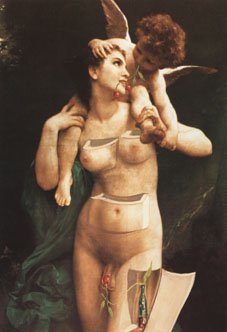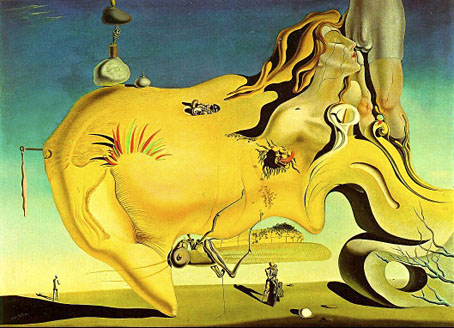Sidewinder (2007).
Promised Land (2007).
Unity mural (2002).
Previously on { feuilleton }
• Paisley patterns
• Flowers of Love
A journal by artist and designer John Coulthart.
Painting
Sidewinder (2007).
Promised Land (2007).
Unity mural (2002).
Previously on { feuilleton }
• Paisley patterns
• Flowers of Love
The paranoiac-critical gaze: Dirty Dalí.
I finally managed to see this fascinating documentary this week. Since my TV broke down some time ago I refused to waste money buying another, partly for the reason that films such as this are increasingly rare and most of them have been shunted to minority channel BBC 4 which I can’t receive. Thanks to BitTorrent you can still find the worthwhile stuff, of course, but this often requires patience.

The Wines of Gala and of God (1977).
Dirty Dalí: A Private View was a reminiscence by art critic Brian Sewell about his encounters with Dalí and wife Gala at their home in Port Lligat in the late 60s and early 70s. What’s interesting about it is the first-hand light it throws on Dalí’s complicated sexuality, a subject which has been the source of speculation in biographies (notably Ian Gibson’s The Shameful Life of Salvador Dalí) but which is confused by the artist’s simultaneous revealing of his obsessions in his art and the veiling of his interests in public statements, not least the frequent declarations of impotence. Sewell confirms that Dalí was interested in both men and women although purely as a voyeur, and relates how his first encounter with the artist led to his having to lie naked in the armpit of a giant Christ sculpture in Dalí’s garden, masturbating while Dalí took photographs. Sewell also examines Dalí’s affair with Federico García Lorca, the closest the artist came to a gay romance, and his subsequent relationship with Gala, which became one where the pair used the artist’s celebrity to attract delectable people of both sexes, like a pair of art world super-swingers. According to Sewell, Dalí’s physical ideal was the hermaphrodite which would possibly explain his attraction to (alleged) transsexual Amanda Lear during this time.

The Great Masturbator (1929).
As a piece of television the film struggles to fill out its running time by resorting to animating photographs, a persistent hazard for documentaries that lack the relevant raw material. All the footage of Dalí is lifted from previous documentary films including a large chunk of Russell Harty’s Aquarius interview, Hello Dali! (that camp double-entendre now seems very apt), from 1973. The overall effect of Sewell’s narrative is to add to Dalí’s already considerable feet of clay but that’s the inevitable outcome of nearly any biography; real lives are always messy. Sewell nonetheless ends by reaffirming Dalí’s principal importance as one of the great painters of the 20th century and, in an interesting side note, declares him to be the last great painter of a religious work with his Christ of St John of the Cross. A great religious artist and also one who produced hundreds of pornographic drawings, some of which are seen in the film. In art, as in the life, the contradictions are everywhere.
• Dirty Dalí at Grey Lodge
• Homage to Catalonia: Robert Hughes on Dalí
Previously on { feuilleton }
• Impressions de la Haute Mongolie revisited
• Dalí and Film
• Ballard on Dalí
• Fantastic art from Pan Books
• Penguin Surrealism
• The Surrealist Revolution
• The persistence of DNA
• Salvador Dalí’s apocalyptic happening
• The music of Igor Wakhévitch
• Dalí Atomicus
• Las Pozas and Edward James
• Impressions de la Haute Mongolie
Another European artist who enjoys invented and ruined architecture. There seems to be little information about him or his work online, however, aside from the links below.
• Interview at ArtsLivre (in French)
• A gallery page
Elsewhere on { feuilleton }
• The fantastic art archive
It wouldn’t surprise me if there are more examples of the fashion world borrowing the Flandrin pose but this is the only one I’ve seen so far, part of a 1998 art-inspired photo series by Mario Sorrenti for Yves Saint-Laurent. There don’t seem to be any larger copies available, unfortunately.
Elsewhere on { feuilleton }
• The recurrent pose archive
Previously on { feuilleton }
• Last Suppers and last straws
• The last circle of the Inferno
(No title) from Sadao Hasegawa 01 (1990).
It’s good to be able to finish the year with another artistic discovery. I’d not come across Sadao Hasegawa’s work before but this page has an extensive (complete?) selection of his paintings and drawings. This is gay erotica with a twist, being Japanese in origin yet incorporating figures and symbolism derived from Indian or Thai mythology, detailed psychotropic invention and the kind of angular motifs common in much illustration and design of the 1980s. A heady brew, in other words, and quite unique as a result, which makes it all the more tragic that he committed suicide in 1999. At least one of his books, Paradise Visions, is still available in Japan but a decent collection of his work for a western audience is obviously long overdue.
Paradise Visions (1996).